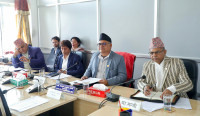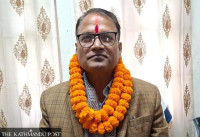National
Gyawali’s overhyped Delhi visit turns out to be a damp squib
There were no concrete outcomes from the visit on the border row or vaccine procurement. It just marked a resumption of bilateral engagements between Nepal and India.
Anil Giri
When Foreign Minister Pradeep Gyawali left for India on Thursday, hopes were high that there would be a concrete discussion on border row, a whirlwind of meetings with the Indian leadership, including Indian Prime Minister Narendra Modi, and a substantive agreement on procurement of Covid-19 vaccines.
When Gyawali returned home on Saturday, he had nothing as such to show.
India made it clear on the day Gyawali reached Delhi that it was not keen on holding talks on the border dispute. Discussions were held on the procurement of Covid-19 vaccines with India’s support, but there was no agreement on its modality.
Gyawali did meet Indian Defence Minister Rajnath Singh on Saturday morning, but Modi “could not manage time” for a meeting because of his busy schedule.
After waiting a while at his hotel for a word on a meeting with Modi, Gyawali then took a 2pm Nepal Airlines flight for Kathmandu.
Many say though Gyawali’s visit does hold some significance in terms of improving ties with the southern neighbour, as it marks the first high-level visit from Kathmandu in over a year, nothing much was achieved in substance.
Upon his arrival in Kathmandu, Gyawali told reporters at Tribhuvan International Airport that his India visit has helped strengthen ties between the two countries.
Gyawali was in New Delhi to participate in the sixth meeting of the Nepal-India Joint Commission, the highest level political mechanism between the two countries mandated to review the status of bilateral ties in a periodic manner.
Before heading for Delhi, Gyawali had said he expected “some progress” in resolving the boundary dispute, some kind of agreement on procuring Covid-19 vaccines and re-establishing the relations at the political level which were fractured by the boundary dispute.
After a gap of bilateral engagements for almost a year, India showed signs of rapprochement with Nepal starting in October when it sent its foreign spy chief to meet with Prime Minister KP Sharma Oli. In November, Indian Army chief and foreign secretary visited Kathmandu and held a series of meetings with the Nepali leadership, including Prime Minister Oli and President Bidya Devi Bhadari. The flurry of visits from India set the stage for Gyawali’s visit to New Delhi.
Gyawali’s visit to Delhi took place at a time when Nepal is in a political crisis—courtesy of Oli, as he on December 20 dissolved the House of Representatives and declared snap polls for April 30 and May 10.
“In diplomacy, what we must be careful about are timing, purpose and clarity,” said Ramesh Nath Pandey, a former foreign minister. “For a high-profile visit like Gyawali’s, it needs maturity in preparations. The Indians did well; their diplomacy was on the spot. Ours was immature.”
The start of the visit itself was awkward, according to many who pointed at how the Indian side was too late in announcing Gyawali’s visit and how India, just hours after Gyawali landed in Delhi, hinted that border talks were unlikely.
Even though there is a practice of announcing bilateral visits simultaneously by the two countries, India’s Ministry of External Affairs made an announcement only Thursday—hours before Gyawali boarded the plane for Delhi. The statement was too brief and said nothing, except his arrival and departure and the Joint Commission meeting on Friday.
As soon as Gyawali landed in Delhi, the Ministry of External Affairs said that India’s position on boundary issues is well known and that the “Joint Commission and boundary talks are two separate mechanisms,” thereby clearly ruling out any possibility of talks on the boundary row at the official level.
That came as a setback, as rhetoric was at its fever pitch before the visit. While addressing the upper house last week, Oli had explicitly talked about Gyawali’s visit to Delhi, saying he would strongly raise the issue of Kalapani, Lipulekh and Limipiyadhura during his talks with his Indian counterpart S Jaishankar.
During a restricted meeting between Gyawali and Jaishankar ahead of the Joint Commission meeting, the Nepali side had raised the boundary issue, according to a member of the Nepali delegation.
“But the Indian side said that they were surprised and shocked at Nepal’s move of publishing a new map including Kalapani, Lipulekh and Limipiyadhura,” said the official. “We were not expecting such a reaction.”
According to the official, the Indian side said that since the two countries now have two different maps, claiming the same territories as their own, it would take a while before the issue is handed over to the foreign secretary level mechanism to deal with.
In 2014, during Modi’s state visit to Nepal, prime ministers of both the countries had directed and mandated their foreign secretaries to work on the outstanding boundary issues, including Kalapani and Susta, and receive required technical inputs from the Boundary Working Group and a mechanism led by survey generals of Nepal and India.
But the mechanism at the foreign secretary level has not met even once in the last seven years.
After India published its new map in November 2019 including Kalapani within its borders, bilateral relations started to sour. Ties deteriorated further when Nepal included the disputed areas in its new map in May in response to India’s inauguration of a road link via Lipulekh to Kailash Mansarovar in the Tibet Autonomous Region of China.
At least two Nepali officials who attended the Joint Commission meeting on Friday told the Post that India instead sought a mandate from the prime ministerial level and instructions for resolving the boundary dispute between the two countries.
Back home on Saturday, Gyawali told reporters that both sides have committed to resolving the border dispute at the earliest possible.
“Both sides have agreed to find a solution to boundary-related disputes,” said Gyawali. Both countries, besides other demarcation, have yet to discuss the boundary row in Susta, Kalapani, Lipulekh and Limpiyadhura, and relevant mechanisms would resolve these disputes.”
Diplomatic sources told the Post that Gyawali’s meeting with Modi did not materialise because of the latter’s busy schedule on Saturday. Modi on Saturday launched India’s Covid-19 vaccination drive, the world’s largest inoculation exercise against the coronavirus.
Political situation in Nepal has also been viewed as a reason why there was no meeting between Gyawali and Modi. Oli’s move of dissolving the House has divided politics in Nepal, according to sources. Political parties in Nepal have been protesting against Oli’s House dissolution move, calling it unconstitutional.
A former Indian ambassador to Nepal said Modi not meeting with Gyawali could be an indication from Delhi that it does not want to involve itself in Nepal’s domestic politics and that it just wants partnership in the economic sector, trade, commerce and other areas.
“A meeting could have become a talking point, and there might have been some concerns that Delhi could face the blame for indulging in Nepal’s internal matters,” said the former diplomat. “That said, China’s growing interest in Nepali politics won’t let Delhi continue its hands-off approach for long.”
A former Nepali diplomat, however, said there is not much to read into Gyawali’s failure to hold a meeting with Modi.
“It would have been better had he met with Modi,” said Madhuraman Acharya, a former foreign secretary and ambassador. “But such meetings do not happen at times, as they depend on various factors.”
According to Acharya, various foreign ministers of Nepal in the past have returned without meeting the Indian prime minister.
Gyawali’s failure to meet with Modi has been criticised on social media as well. Social media users mostly hinted at the recent visits from India, when officials usually meet with a wide range of political leadership in Kathmandu, including the prime minister and the President.
Indian Foreign Secretary Harsh Vardhan Shringla in November had met with President Bhandari, Prime Minister Oli and Foreign Minister Gyawali after holding bilateral talks with his Nepali counterpart Bharat Raj Poudyal.
“It is true that we have been exercising some uneven kind of tradition... like any Indian foreign secretary who comes to Kathmandu on an official visit does call on the head of state and government head,” said Acharya. “But if Gyawali could not meet the Indian prime minister, there is nothing new. Such incidents have happened in the past as well.”
According to Acharya, the meeting may not have happened also because Gyawali is representing a caretaker government in Nepal.
“But what is more important, at least for me, is whether we could secure Covid-19 vaccines or not,” said Acharya. “This I think should have been the primary interest of Nepal during this visit.”
The Nepali side has requested India to supply around 12 million doses of vaccines, as the government plans to inoculate 6 million people in the first phase.
Sources said India has given assurances to that effect. India has said some doses will be made available within January but the amount was not revealed, according to the sources.
Covid-19 vaccine was one of the top agendas of Gyawali’s visit, apart from the boundary issue.
Since not many political meetings took place, Gyawali used every other platform to justify Oli’s House dissolution move.
On Friday, addressing a function at the Indian Council of World Affairs, Gyawali said the House was dissolved to seek a fresh mandate to “make the people of Nepal sovereign”.
On Saturday also, speaking to the Indian media, Gyawali defended the House dissolution, terming it an action in response to the problems faced by the Oli government for a long time.
“The government had been facing troubles for long so the House dissolution came as a result of that. In the parliamentary system, if a prime minister elected by a majority vote thinks that he should go for a fresh mandate, as per globally established norms, it is correct to dissolve the House,” said Gyawali.
“In a democracy, people have the right to make decisions on the future of the country. Oli's decision to seek a fresh mandate helps in our goal of prosperous Nepal and happy Nepalis.”
At yet another programme on Saturday, Gyawali said that the [upcoming] elections will provide an important opportunity for the people [of Nepal] to make their choice and strengthen the foundation of democracy.
All in all, observers say, the visit can be seen as a sign of the resumption of bilateral engagements which had taken a back seat for a while.
“There was hardly any surprise for the Indians, as we had already made public our strategy,” said Pandey. “How can we expect a concrete outcome from a visit when preparation for the same was utterly lacking. The visiting minister and the prime minister had already made a lot of noise about the visit.”
Suresh Raj Neupane contributed reporting from New Delhi.




 8.12°C Kathmandu
8.12°C Kathmandu















